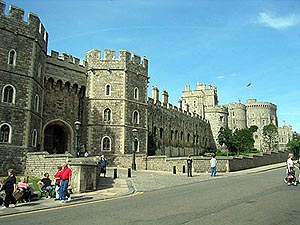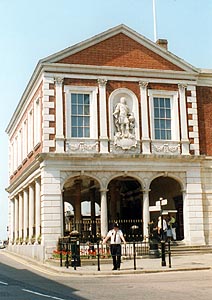
RBH Home
Maps & Travels
Articles
Legends
Towns & Villages
Castles & Houses
Churches
Biographies
Gentry
Family History
Odds & Ends
Mail David
Windsor
Royal Town & Castle
 Windsor,
of course, is the home of the Queen. The Royal family have lived at the
castle here since King William the Conqueror first built it in the
mid-11th century. The present building on the hill is largely 14th century
with extensive Georgian embellishments and dominates the town from all
angles. The state apartments, with their spectacular interiors and some of
the finest works of art in the country, are open throughout the year; as
well as the lower ward and St. George's Chapel
where many of the Royal
family have been buried over the centuries. There are beautiful memorials
from medieval monarchs like Edward IV to modern losses, like the late King
George VI. The 15th century Garter stalls make a fine sight leading up to
the high altar in a blaze of colour. The Order still meets at the castle
and the Garter Ceremony is a regular event in the town.
Windsor,
of course, is the home of the Queen. The Royal family have lived at the
castle here since King William the Conqueror first built it in the
mid-11th century. The present building on the hill is largely 14th century
with extensive Georgian embellishments and dominates the town from all
angles. The state apartments, with their spectacular interiors and some of
the finest works of art in the country, are open throughout the year; as
well as the lower ward and St. George's Chapel
where many of the Royal
family have been buried over the centuries. There are beautiful memorials
from medieval monarchs like Edward IV to modern losses, like the late King
George VI. The 15th century Garter stalls make a fine sight leading up to
the high altar in a blaze of colour. The Order still meets at the castle
and the Garter Ceremony is a regular event in the town.
The Changing of the Guard at Windsor takes place at 10:50am every day (or every other day depending on the time of year, never on a Sunday though). The soldiers can be seen marching up the High Street and they return at 11:30am. Other popular events include the annual Windsor Rose Show held beneath the castle walls and the Swan Upping on the river in mid-July. The Queen's Swanherd and his crew, along with those form the Vintners' and Dyers' Livery Companies, ceremonially mark their swans on the Thames and salute the Queen at the castle by shouting "Her Majesty the Queen, Seigneur of Swans!"
The quaint little streets surrounding the entrance to Windsor Castle give some impression of the town in times past. These days, they are crammed with coffee houses and gift shops. There are further souvenir and sweet shops trailing down the hill along Thames Street, as well as eating venues. There is an excellent Chinese Restaurant at the lower end near the Theatre Royal, famous for its high quality productions. This area is down near the River and the bridge to Eton, home of the famous school founded by Henry VI in the 15th century. There are always swans to feed (watch your fingers!) and river trips to take; chips or ice-cream to eat. Explore the parks or watch a game of bowls nearby. This is a good area for parking, though it's often easier to get into the King Edward Court Multi-Storey.
Back at the top of the hill is the Harte and Garter Hotel, where Shakespeare wrote the 'Merry Wives of Windsor'. Open carriage rides are often available outside, or you could explore the town on an open-top bus tour available from March to November. The old Railway Station has recently been turned into an up-market shopping arcade featuring many fine quality London retailers: jewellery, perfumes and clothing boutiques. There's even an old steam locomotive to explore. Peascod Street is the main shopping street heading down the hill directly opposite the castle entrance. It is fully pedestrianized and here we find most of the big High Street names. There are also three small department stores. 'Daniels' is particularly well known for its excellent toy department.
 The
High Street stretches away at right angles. The shops soon peter out in
favour of the Guild Hall, the parish church (and brass rubbing centre in
Summer) and fine Georgian homes. The former was built by Sir Christopher
Wren, architect of St. Paul's Cathedral in London. Look carefully at the
supporting pillars which do not touch the floor above. Sir Christopher
inserted them only on the insistence of the borough authorities who did
not trust his design to hold the building up! The overcrowded Tourist
Information Centre tends to be rather London orientated, but has a good
'Town and Crown' historical exhibition upstairs. Further along, at the
junction with Park Street is a unique blue post box for George V's
air-mail. You then come to the Great Park gate (near a good pub). There
are super views of the south-side of the castle's quadrangle here and, of
course, the Long Walk leading to the Copper Horse far away in the
distance. Nearby, when the trees are not in leaf, can be seen the tower of
the Royal Mausoleum at Frogmore House where Queen Victoria is interred.
Both are open to the public on a very small number of specific weekdays in
the Spring & Summer. Enquire locally for details.
The
High Street stretches away at right angles. The shops soon peter out in
favour of the Guild Hall, the parish church (and brass rubbing centre in
Summer) and fine Georgian homes. The former was built by Sir Christopher
Wren, architect of St. Paul's Cathedral in London. Look carefully at the
supporting pillars which do not touch the floor above. Sir Christopher
inserted them only on the insistence of the borough authorities who did
not trust his design to hold the building up! The overcrowded Tourist
Information Centre tends to be rather London orientated, but has a good
'Town and Crown' historical exhibition upstairs. Further along, at the
junction with Park Street is a unique blue post box for George V's
air-mail. You then come to the Great Park gate (near a good pub). There
are super views of the south-side of the castle's quadrangle here and, of
course, the Long Walk leading to the Copper Horse far away in the
distance. Nearby, when the trees are not in leaf, can be seen the tower of
the Royal Mausoleum at Frogmore House where Queen Victoria is interred.
Both are open to the public on a very small number of specific weekdays in
the Spring & Summer. Enquire locally for details.
The Great Park is the last remnant of the vast Windsor Forest. It is an enormous deer park enclosed by the Medieval Kings and the deer are still frequently seen grazing in the open. It is a marvellous area for the keen walker to explore. There are several interesting keepers' and Royal lodges to seek out and a village hidden away from everyday traffic. It stretches all the way to Virginia Water, the Savill Gardens and the Surrey border. In the Summer, there are demarked areas where you may drive your car onto the grass and sit beneath the shady trees. It is often akin to an inland beech with many sun-bathers and ice-cream vans.
Windsor Race Course lies to the west of the town, where there are regular race meets, but the most popular attraction for all the family must be the Legoland Theme Park. This fun-packed pleasure ground is located off the B3022 Winkfield Road (commonly and misleadingly known as the 'Safari Park Road') on the edge of town. A World constructed of the famous children's building bricks from Denmark: Minature landscapes, a fairytale castle complete with fire-breathing dragon, fairground type rides and rollercoasters, daily shows, boating, go-carts, fireworks displays. Legoland has it all!
Next: Maidenhead
